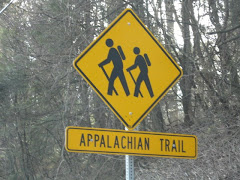Claudius Smith and gang (including his three sons) terrorized southern Orange County, NY during the Revolutionary War from 1774 to 1779. The British sympathizer first stole horses and cattle to sell them to British troops, then began raiding homes and farms. At times they even burned the homes and murdered the occupants.
They hid out in the rocks in what is now Harriman State Park. The upper chamber was used as their den and the lower chamber (pictured on the left) was used as a horse stable.
And so we begin! First, take the NY Thruway to exit 15A, at the end of the ramp turn left at the light and continue on Route 17 North. After about 4.5 miles you will see the Tuxedo Train Station on your right. Continue past and make the next right over the railroad tracks and park in the left commuter parking lot (this is free parking on the weekends and holidays).
Now, you might hear that this is a moderate hiking trail, well my friends, after hiking this loop twice, I'm here to tell you it isn't. But while it is a hard 8 miles, the views are spectacular and extremely rewarding.
When you're ready, walk out to the road from the lot and turn left, you will see a red-dot-on-white trail marker (Ramapo-Dunderberg Trail) on a wooden sign. This is where we begin. Follow the winding road as it passes through a tunnel under the highway. Follow the RD trail markers as the road turns left and continues to the base of the mountain.
Follow the RD trail as we climb the mountain over a rocky trail on switchbacks for a 500 foot vertical climb (aren't they all in NY?). After the trail levels off, you will see the yellow-blazed Triangle Trail continue straight, but we want to bear right and continue on the red-dot-on-white blazed trail.
Our first scenic stop comes soon after we make that turn. On the left you get a spectacular view of the town of Tuxedo and the NY Thruway. But, we have a lot of trail ahead of us! Continuing on the RD trail, pay close attention, on the right you will seen an unnatural pile of rocks (see right picture), if you leave the trail and walk around the rocks, you will find the Black Ash Mine!
After leaving the mine, keep following the RD trail until you come to signs for the blue-disc-blazed Victory trail. At this point, look to your left and continue to follow the RD trail sharply up the mountain.
After hiking for awhile, you will cross the White Bar trail. Keep going until you once again meet with the yellow-blazed Triangle trail. Here, turn right onto the yellow trail and work your way down the mountain. Soon after you turn onto the yellow, you will come to a spot where you turn right and have to step down a rocky natural step. If you look right, you will see a bear den, best to leave it alone (right L&O!!).
Follow the uneventful yellow-blazed trail until you reach Lake Skenonto. Relax and take a well deserved break, we are now more than half way through our loop!
When you are ready, follow the trail back out, but this time, turn left onto the blue-blazed Victory trail. This vintage looking trail is an old service road, yet it is anything but easy. Continue on it until you reach the point of intersection with the RD trail. Once here, follow the blue-disc-blazed trail to the left and over a stone bridge across the small stream leading from the Black Ash Swamp.
The blue-disc-blazed trail will lead you to the Claudius Smith Den overlook. Soon after the overlook, the blue-disc ends and we pick up the red-blazed Tuxedo-Mt. Ivy trail. It is the red-blazed trail that will lead you right into the den.
Once you are finished exploring the "Cowboy of the Ramapos" former hideout, continue to follow the red-blazed TMI trail until its terminus, then make a left onto the RD trail once more, taking it back to the parking area.






